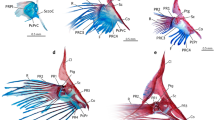Abstract
The asymmetric pincer and snapper claws in the snapping shrimp differ in external morphology and musculature. The snapper is a massive claw used for displays and defense; the pincer is small and slender, used for feeding and burrowing. The snapper has only slow muscle fibers; the pincer has both slow and fast. Removal or denervation of the snapper claw induces transformation of the contralateral pincer to a snapper type of claw at the subsequent molt. A removed claw regenerates as a pincer type, as long as the innervation of the remaining claw is intact. Fast muscle fibers, found exclusively in the pincer claw, normally degenerate completely within 10 d after the moult, which transforms the pincer to a snapper. Morphological transformation of the pincer following removal of the snapper claw can occur even if the pincer claw is denervated. Denervation of the pincer, however, delays degeneration of the fast fibers, increasing the estimated half-time for muscle degeneration, from 4.4±0.2 to 19.5±0.8. d after the transforming moult. Neural influences there-fore are involved both in the determination of the morphology of the claw and in the induction of degenerative changes during the remodeling of an existing claw.
Similar content being viewed by others
References
Davies M., Thoenen H., and Barde Y. A. (1986) Different factors from central nervous system and periphery regulate the survival of sensory neurons.Nature 319, 497–499.
Govind C. K. and Pearce J. (1988) Remodelling of nerves during claw reversal in adult snapping shrimps.J. Comp. Neurol. 268, 121–130.
Mearow K. and Govind C. K. (1986) Selective degeneration of fast muscle during claw transformation in snapping shrimps.Dev. Biol. 118, 314–318.
Mellon DeF, Jr. and Quigley M. M. (1988) Disruption of muscle reorganization by lesions of peripheral nerve in transforming claws of snapping shrimps.J. Neurobiol. 19, 532–551.
Mellon DeF., Jr. and Stephens P. J. (1978) Limb morphology and function are transformed by contralateral nerve section in snapping shrimp.Nature 272, 246–248.
Mellon DeF, Jr., Wilson, J. A., and Phillips, C. E. (1981) Modification of motor neuron size and position in the central nervous system of adult snapping shrimps.Brain Res. 223, 134–140.
Mykles D. L. and Skinner D. M. (1982) Molt cycle-associated changes in calcium-dependent proteinase activity that degrades actin and myosin in crustacean muscle.Dev. Biol. 92, 386–397.
Ogonowski M. M. and Lang F. (1979) Histochemical evidence for enzyme differences in crustacean fast and slow muscle.J. Exp. Zool. 207, 143–151.
Wilson E. B. (1903) Notes on the reversal of asymmetry in the regeneration of the chelae inAlpheus heterochelis.Biol. Bull. 4, 197–210.
Young R. E., Pearce J., and Govind C. K. (1994) Establishment and maintenance of claw bilateral asymmetry in snapping shrimps.J. Exp. Zool. 269, 319–326.
Author information
Authors and Affiliations
Rights and permissions
About this article
Cite this article
Young, R.E., Wong, A., Pearce, J. et al. Neural factors influence the degeneration of muscle fibers in the chelae of snapping shrimps. Molecular and Chemical Neuropathology 28, 295–300 (1996). https://doi.org/10.1007/BF02815235
Received:
Accepted:
Published:
Issue Date:
DOI: https://doi.org/10.1007/BF02815235




